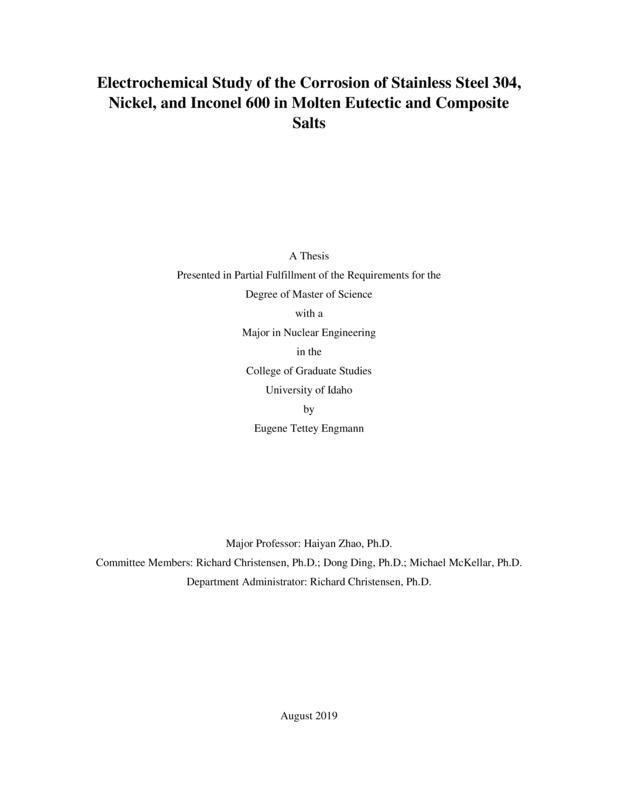Electrochemical Study of the Corrosion of Stainless steel 304, Nickel, and Inconel 600 in Molten Eutectic and Composite Salts
Engmann, Eugene. (2019-07). Electrochemical Study of the Corrosion of Stainless steel 304, Nickel, and Inconel 600 in Molten Eutectic and Composite Salts. Theses and Dissertations Collection, University of Idaho Library Digital Collections. https://www.lib.uidaho.edu/digital/etd/items/engmann_idaho_0089n_11687.html
- Title:
- Electrochemical Study of the Corrosion of Stainless steel 304, Nickel, and Inconel 600 in Molten Eutectic and Composite Salts
- Author:
- Engmann, Eugene
- Date:
- 2019-07
- Embargo Remove Date:
- 2021-03-03
- Program:
- Nuclear Engineering
- Subject Category:
- Materials Science
- Abstract:
-
Stainless steel 304, Nickel, and Inconel 600 were tested for corrosion as working electrodes electrochemically in 0.67Li2CO3-0.33K¬2CO3 eutectic salt, and 0.3 GDC – 0.7 (0.67Li2CO3-0.33K¬2CO3) composite salt from 500 to 600 °C in the air. The aim of this study was to understand the corrosion mechanism that take place on the electrode surface, and for materials screening in terms of corrosion resistance in both salts. The electrochemical methods employed were Linear polarization resistance (LPR), Tafel analysis, and electrochemical impedance spectroscopy (EIS). The best scan rate of 1mV/s was determined for the LPR and Tafel measurements after conducting a parametric study with different step heights and step times. According to both the LPR and EIS measurements, Stainless steel 304 demonstrated the highest resistance to corrosion in the eutectic salt with high resistance polarization (Rp) and Rct values; which measure charge transfer, and consistent and high P values which measure permeability of the salt through the oxide layer, owing to stainless steel 304 rich Cr content. Inconel 600 performed the second best, possibly due to its chromium content as well. Nickel came in third with low resistance to eutectic salt. In the composite salt, according to the Rp, the icorr and the P values, Nickel ranked exceptionally high possibly due to the formation of a composite nickel oxide cerium gadolinium oxide (NiO-CGO) film on the surface if the nickel electrode. Inconel 600 ranked second, followed by stainless steel. Temperature also played a significant role in contributing to the acceleration of corrosion. As temperature decreased, the resistance of stainless steel 304 to corrosion increase in the eutectic salt. However, for Inconel 600, at higher temperatures resistance to corrosion was high. The corrosion mechanisms based on EIS results using equivalent circuits revealed that the corrosion for the metal structural materials in the salts includes oxide layer formation, and various oxide layers formation with diffusion control and electron transfer.
- Description:
- masters, M.S., Nuclear Engineering -- University of Idaho - College of Graduate Studies, 2019-07
- Major Professor:
- Zhao, Haiyan
- Committee:
- Christensen, Richard; Ding, Dong; McKellar, Michael
- Defense Date:
- 2019-07
- Identifier:
- Engmann_idaho_0089N_11687
- Type:
- Text
- Format Original:
- Format:
- application/pdf
- Rights:
- In Copyright - Educational Use Permitted. For more information, please contact University of Idaho Library Special Collections and Archives Department at libspec@uidaho.edu.
- Standardized Rights:
- http://rightsstatements.org/vocab/InC-EDU/1.0/

